By Bonnie Cassen
The message simply said “Saturday 24th April big rally Parliament House in Hobart. Flights are cheap do you want to go? Save the Tarkine!!” Of course I wanted to go – there is so much environmental vandalism in Tasmania – what conservationist could resist?
I know air travel creates emissions, but I didn’t charter the flight, in fact we were sardined into the packed Jetstar flight, we offset the emissions, were there to do good, get inspired and bring back anything we could learn for the various common issues also waged in NSW on the South Coast. After all the Tasmanian State Government is historically the most corrupt of them all, hell bent on paving the way for corporate profits at the cost of the environment.
Tasmania is a wonderous wilderness area in a state known for its love and respect for nature. Bushwalking, canoeing, adventuring and bird watching attract locals and visitors to world heritage forests as much for the breath-taking beauty as for the serene peaceful energy it emits.

To have decade after decade of governments that support and subsidise destructive industries that trash the environment doesn’t make sense. Really destructive industries too such as fish farming, clear-fell logging, mining and greedy over-development. We figured any little way we could help while we were there would be useful.
Inspiration was not hard to find
Inspiration was something I picked up in droves. We were met at the airport by Cass, long time Wilderness Society, Bob Brown Foundation (BBF) and Extinction Rebellion (XR) campaigner and running jellyfish researcher Dr Lisa Gershwin’s campaign as an independent for the state lower house.
Of course, Dr Gershwin has little chance of getting elected; she has three campaign workers, (poor Cass falls asleep at her computer most nights), no corflutes (Liberals bought out all the signage in the state and they ended up finding a few old ones somewhere and hand painting them), and a very limited budget. Elections however provide a fabulous platform to voice a cause and that is an opportunity Lisa Gershwin never passes up.
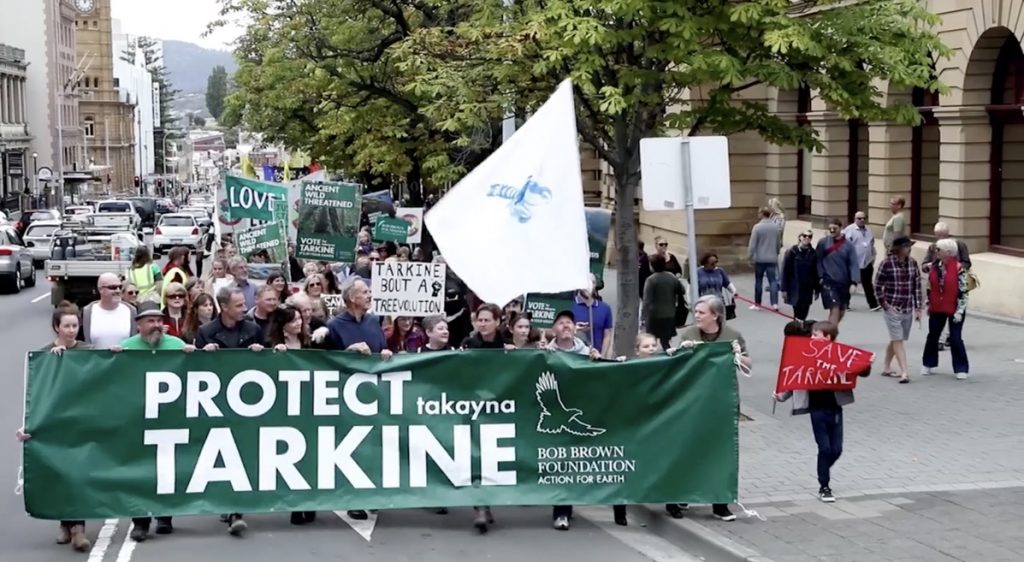
Gaby who we stayed with is an activist sculptor and also connected with BBF and XR. She and Cass were arrested together at a protest last year. A few years ago, Gaby rode her electric trike (like an electric push bike but a trike) to the Tarkine frontline. It took ten days including two rest days and she raised money and dropped into schools to raise awareness along the way.
The logging story
Having offered ourselves to the Bob Brown Foundation for a few days, we were happy to undertake some postering and stickering of the area while seeing a bit of Hobart. The BBF campaign was focused on encouraging voters to use their vote for the environment and that if they weren’t voting for people willing to place strong protections on the Tasmanian environment then they were part of the problem.

We made our way through the city down towards the water and the docks finding ourselves at Macquarie Wharf. There we found the logs. Logs for as far as the eye could see in both directions, and rows and rows of them. These whole logs were from native forests, once habitat forests for wedge-tailed eagles, masked owls and critically endangered swift parrots. Now they line the wharf waiting to be shipped off overseas for export.
We could tell the logs weren’t plantation as there was no uniformity of size and some were quite large, possibly containing hollows before they were culled and milled. The sight was quite confronting knowing that they had come from ancient world heritage wilderness forests.
Conservationists have been fighting logging in Tasmania for over three decades, little progress being achieved through advocacy and political channels, but front-line direct action gets the desired results most of the time.
Although forest agreements were made whereby the Tasmanian logging industry was paid and compensated not to log, since the moratorium ended last year, the Tasmanian Government has reopened 356,000 hectares for logging including 100,000 hectares in the Tarkine.
Across Tasmania, there are more than a million hectares of native forests threatened by logging. Currently activists are putting their bodies on the line to interrupt logging activities and have been very successful in stopping planned activities.
These forests are also home to a number of threatened species including Tasmanian devils, swift parrots, spotted quolls as well as the wedge-tailed eagle and the masked owls. Wildlife can’t survive without sufficient habitat to support their communities and when their homes are razed, many die while others move on and have territorial competition to deal with. Activist’s report seeing and hearing these animals while camped out in the forest.
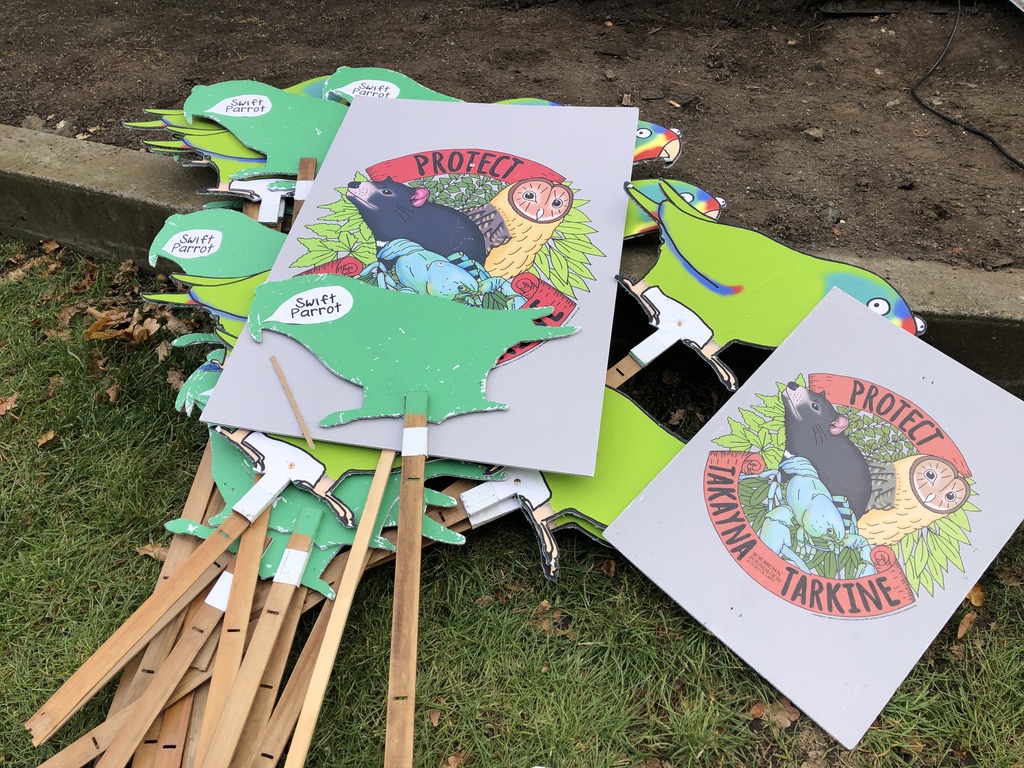
These forests store a huge amount of carbon. Deforestation is one of the biggest drivers of climate change,
Forest Activist Dr Lisa Searle, a GP who also works with Médecins Sans Frontières, doesn’t mince her words in talking solutions. “We need to stop cutting down trees, we need to stop clear-felling, and we need to maintain and protect any forest that we have left on this planet.”
The Tarkine, or takayna is a special place, one of the last ancient Gondwana rainforests remaining in the world. On the ground it is wet adding to the rich scent of eucalypt that fills the air. Fungi is abundant, green mosses vibrant. Majestic sassafras, leatherwood myrtles and blackwood – more than 60 vulnerable and rare species call this home – many endangered.
The destruction of clear-felling
The practice of clear-felling is destructive. Entire areas – forestry says of up to 80 hectares at a time – are bulldozed, cleared, flattened using massive industrial sized machines. After sorting the prize, sawlogs, peelers and woodchip the rest – understory, small eucalypts, regrowth and slash (tops and tails unsuitable for woodchip) are torched, incinerated by fires of such intensity that everything is burnt including seed banks in the soil layers.
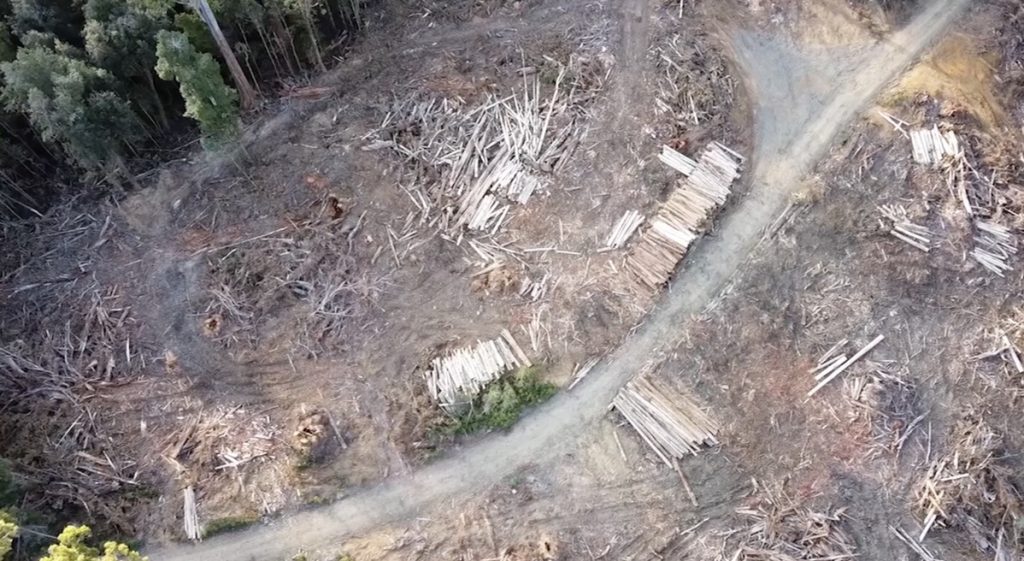
Worse still is that napalm is used – yes napalm. It is dropped from helicopters to scorch any surviving plants or animals before the blazing. Locals describe how heartbreaking it is to see the characteristic plumes of smoke hanging over the hills and knowing another area of forest has been masticated.
Knowing how deadly napalm is, it is incomprehensible that its use is legal. It is not hard to imagine the deadly contamination to wildlife in surrounding forest areas as well as to bushwalkers and adventurers and those who live in nearby areas were the smoke and its contaminants diffuse.
I heard from reliable sources that carrot sticks and poison, 1080, are left out to stop wildlife venturing into the plantation and eating the seedlings. By stop I mean kill. Knowing that large numbers of wildlife that initially survived the Black Summer bushfires later died from smoke inhalation, there must also be a carry-over legacy from these fires.
After such a blazing nothing remains; all biodiversity stripped, all nutrients, all organic material, and all carbon stores are lost. The coup is then reseeded with monoculture species, essentially a replacement plantation forest within a once-forest has been created. A plantation of high density, single age monoculture lacking any biodiversity.
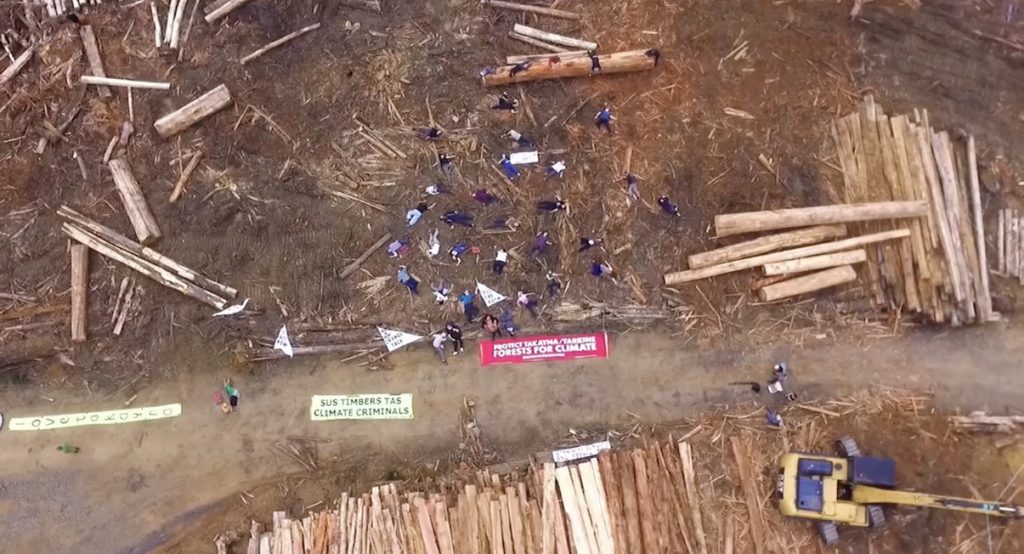
What is even crazier is that after such degradation to the soil the plantation is only likely to produce two or three regrowths before the area becomes a barren infertile wasteland. All this death and destruction from an unprofitable industry that is heavily subsidised and that contributes heavily to climate breakdown. The mandatory Liberal ‘jobs’ cry is an exaggeration and becoming overused and boring.
The Malbena matter
I really wasn’t looking to feel better about the NSW State Government, but in terms of developer greed and bending over backwards to bow to their whims, the Tasmanian Liberal Government really takes the cake.
The privatisation of National Parks is a huge issue. Private developers have been gifted parcels of land and in the case of Lake Malbena, an entire island for a ‘peppercorn lease’ of $20 per week. The developer now has exclusive possession of the island which is in a world heritage area and plans to build helicopter accessed huts as tourism accommodation on Halls Island.
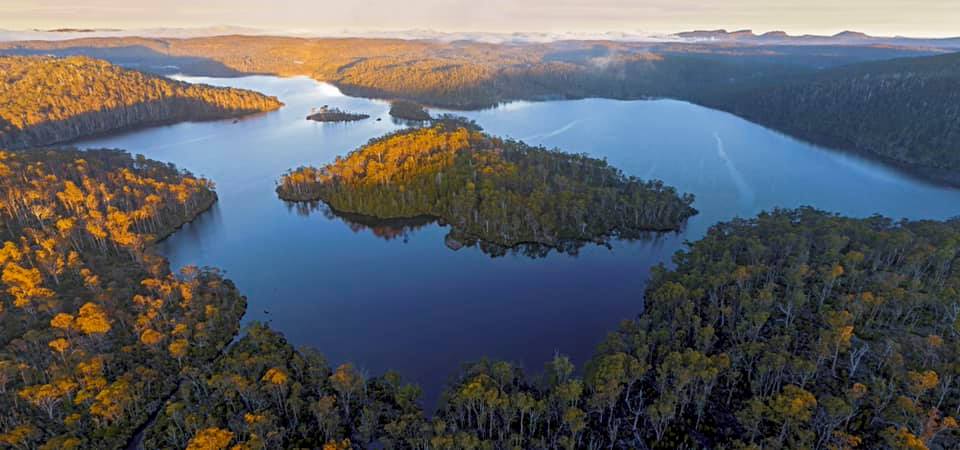
I caught up with Dan Broun from the group Fishers and Walkers Against Helicopter Access Tasmania who are actively opposing the development.
“What the exclusive possession means is we aren’t allowed to go there anymore. As bushwalkers and anglers we have been going there for decades – it’s a beautiful beautiful place, and we aren’t allowed to go there anymore unless we have the permission of a property developer.”
The developer has permission to install surveillance cameras and evict people from the island who are ‘trespassing’.
“The Tasmanian Government would like to do this across every world heritage area and national parks and there are 60 proposals lined up.” Mr Broun tells me. “This one is the test case. The one they are trying to get across the line to open up the way and justify the rest.”
There is a huge amount of support for the Malbena Matters campaign. The public have rejected it with every survey conducted showing 95 per cent against the developments and only five per cent either in support or ignorant of the issue. While individual Labor MPs are showing in principal support for the campaign, as a party they are not supportive.

“Labor are not supporting us as a party, they’re in lock-step with the Government, most likely because of political donations.” Mr Broun said. “A few Labor MPs and candidates have quietly offered their support to us when it comes to the caucus that is another thing.”
Fishers and Shooters have been surprisingly quiet about this issue, although they have voiced opinions against it in the past, but during this election have remained quiet. Most of the independent candidates are 100 per cent opposed, as are The Greens.
“People are really opposed to being locked out of their own land, and that’s what is happening. National Parks bushwalking is a favourite pastime and part of the Tasmanian culture, and the Liberal Government is trying to monetise it and privatise it.”
Greater transparency in National Park planning
Kiera Smart from the Tasmanian Wilderness Guides Association wants to see greater transparency in the development and application process of tourism developments in national parks.
Currently development applications in national parks are made through an expression of interest and a reserve activity assessment which rely on the applicant’s own assessment of their proposals. National Parks belong to the public who have a right to a process with proper statutory processes within Tasmania’s planning legislation and with third party appeal rights.

Photo supplied
The group believes there must also be fairness in business licencing. Currently lease arrangements are negotiated individually and vary from one cent per quarter for the use of the Three Capes Track to $20,000 per quarter at Cradle Mountain, and of course the $20 lease for Halls Island at Lake Malbena.
Cable cars down the mountain?
This proposal could easily have come straight out of Kiama Council, its inappropriateness only overshadowed by its environmental impact.
“They want to put the cable car right across the face of the mountain,” campaigner Jenny Woodward from the Residents Opposed to the Cable Car group told me. “A lot of people don’t realise that – three very big towers the top one above the organ pipes which is geologically unstable already. There have been a lot of rock falls in the area. And that’s a problem in itself as the drilling and building work would destabilise the area.”
The cable car proposal was one of the first pointed out as we circumnavigated the mountain heading to Hobart from the airport. Front yards displayed banners and posters opposing the tourist development.
The plans include a top tower covering 35 metres and a large visitor centre, the station area where the people get on and off is about 120 metres long and four stories high. These are areas of high Aboriginal heritage significance and no actual study has ever been completed, just some computer-generated analysis.
The project would require contractors to explode and detonate an estimated 25 swimming pools of rock, plus make a 2.5-kilometre road to the base station through the forest. The development includes cafes, a whiskey bar and restaurant, as well as a visitor centre and depot hub at the top of the mountain.
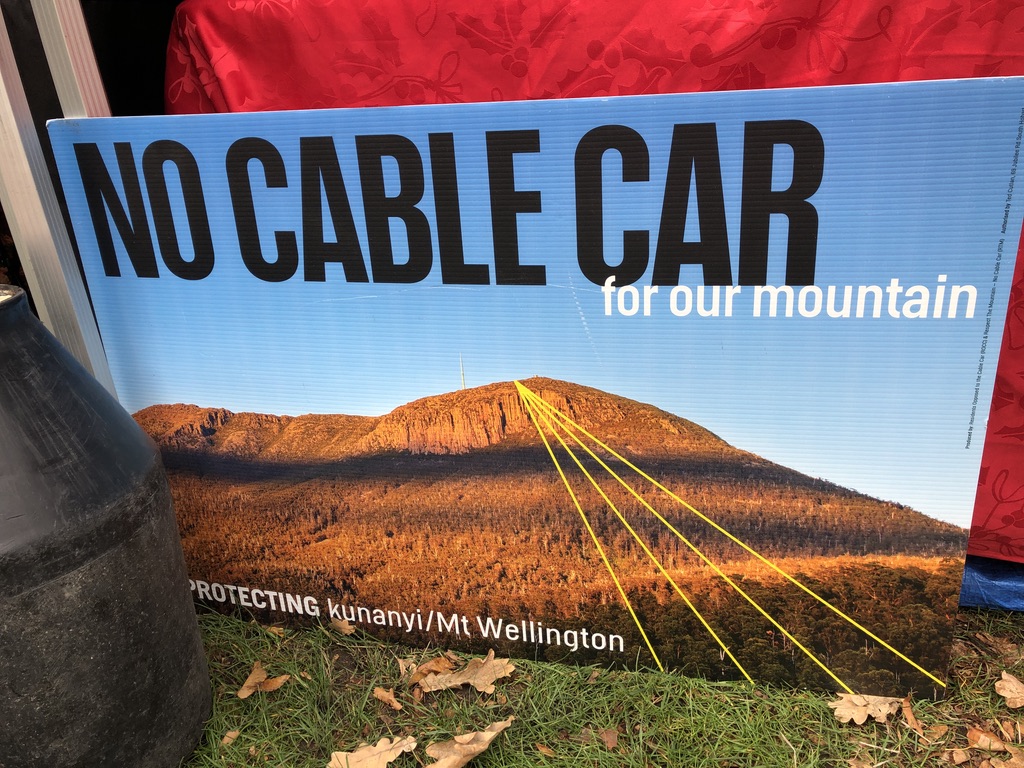
The claim is that the cable car with the access road down the bottom will take traffic off the road, but Ms Woodward said with the amenities planed for the top, additional traffic will be attracted to the top to access these and to avoid the cost of the cable car.
“We feel the traffic to the mountain will actually increase with the visitor hub at the top,” she said. “As well as moving through some threatened forest – peppermint eucalypt – and all the while promoting it as an environmental venture.”
The Mount Wellington Cableway Company (MWCC) claimed back in June 2019 when it lodged its development application that an assessment had found no Aboriginal heritage sites within proximity to the base station or tower locations. However it has since been revealed that only a computer analysis has actually been conducted.
The Aboriginal community constantly come up against similar stances from developers who they believe have little understanding of Aboriginal heritage or their connection to their heritage. While archaeological evidence highlights the prevalence of Aboriginal heritage, the connection runs far deeper. It’s about spiritual connections, something MWCC doesn’t appear to understand in its quest to develop tourism mechanisms wherever it can.
Towards a transparent robust strategic planning system
I sought out Sophie Underwood from Planning Matters Alliance Tasmania for a chat; I had heard about the alliance and was keen to hear what the issues were. The alliance represents 70 community groups across the state and faces similar planning and development issues to us in regional NSW.
Essentially, they want to see the planning system balanced and are not anti-development.
Ms Underwood said, “We want a balance between what the developers want and what the community want. It needs to be a fair system. And at the moment, it’s not, and it’s moving in a direction that’s even worse.”
“The planning scheme essentially affects every inch of the state,” she told me. “It will create our future. And it’s complex and hard to understand. This is why we formed the alliance.”
The State election is an opportunity to put planning issues back on the agenda but with the average person lacking confidence in planning jargon, a simple platform was created to help people contact their MPs and ask the right tough questions.

Ironically in the week I have been back from Tassie two inappropriate ‘only in emergency circumstances’ developments were rushed through avoiding community consultation. Another approved over ten years ago has a community on tender-hooks, expecting a developer to lodge for commencement clearance any day. As I travel south today I wonder what else in going on in the development realm.
And a bit of hope for the future
At the Rally for the Environment, I met Hugh Nicolson from the Grassroots Action Network Tas who is part of a group empowering and giving a voice to young people concerned not just about the environment but about social justice issues as well.
“Environmental and social justice work and community building is our main thing and every week we host a gathering of generally young people, but older people too.” Mr Nicolson said. “We plan actions and events and have a community garden and office space provided by the Wilderness Society for our use.”
“Last Sunday the group held a rally here at Parliament house where they had speakers on a wide range of issues from housing to health care to the environment. This week they are back with a stand to raise awareness for the group.
“Down here with our history of environmentalism in Tas, young people know what’s going on.” He told me, “We are trying to give a channel for some of that energy and empower people to do things they want to do to make a difference.”
Groups such as Australian Climate Youth Coalition (ACYC) and Extinction Rebellion are also active in the area. In September 2019 over 22,000 young people and their supporters turned out in Hobart to call for strong climate action. That’s nearly 10 per cent of the city’s population and an indication of how important the issue is to the local people.
I also met the Extinction Rebellion Suffragettes at Hobarts Parliament House whose spokesperson’s message was pretty clear, “people need to realise that just like the suffragettes fought for the vote, we have to fight for the climate emergency to create the system change we need, now.”

Tasmanians are well versed at putting their bodies on the line. When all other actions fail and placards and demands fall by the wayside, direct peaceful actions are all that is left, and numbers. How many people turn out to protests gives governments an indication of the importance of an issue. They know the statistics better than us of how many people care and remain silent compared to those who act.
Extinction Rebellion estimate that it will take just three per cent of the population on the streets to get the attention we need to make political change. In Australia that represents around 800,000 people – much less than the 10 per cent I had always thought was necessary.
Vote for the environment rally
Covid restrictions meant the vote for the environment rally on the Saturday was limited to 1,000 people which was easily achieved.
Jenny Weber the campaign manager at the Bob Brown Foundation began the rally by saying, “The promises made in this election campaign from new roads to tourism and education or health is just rearranging the deck chairs on the Titanic unless we secure our environment and climate.”
She acknowledged the pandemic across the globe was a result of habitat destruction and that the world was on notice. “We need to restore the environment and protect habitat, or we will see more pandemics. Global leaders are calling for every community to invest in nature protection and restore our earth. That is exactly what the Bob Brown foundation is doing.”
Lisa Searle held the crowd captivated as she spoke. “I spent a night just a few days ago in an active logging coop in the Wentworth Hills area in the central highlands of Tasmania and it was minus three degrees that night.” She said. “We managed to stop the logging for the day. All around us on the ground were the trunks of what used to be ancient trees in huge piles.”
Dr Searle described the enormous trees – hundreds of years old – that provided habitat for a huge range of creatures including threatened and endangered species.

“I stood there and watched as a friend of mine an incredibly brave and staunch forest defender who had attached himself to one of these forest destroying machines in subzero conditions was arrested by police and loaded into the paddy wagon for standing up for the forests. I watched alone while an eagle flew directly overhead. In that logging coupe there are three known wedge tailed eagle nests and yet they are allowed to continue logging.”
“Sustainable Timber Tasmanian knows that these forests are home to threatened and endangered species and yet they continue logging,” Dr Searle said. “Both the liberal and Labour parties have made their stance on native forests abundantly clear. They not only allow this practise to continue. They actively encourage it.”
“I was arrested recently in the Tarkine on Venture Minerals Riley Creek mine site. This is a new iron ore mine that's currently under construction in the Tarkine wilderness. The magistrate decided that a fine and a conviction was not enough to deter me. She's given me an 18-month community corrections order to try to deter myself and others from standing up and taking action.”
“We need the people in power to know these strategies will not work. It doesn't matter what they do. We're not going to give up as long as our forests are still falling, as long as our governments refuse to take any kind of climate action, and as long as the Tarkine remains unprotected. We will continue to stand up, to stand together, and we will keep fighting for what we know is right.”
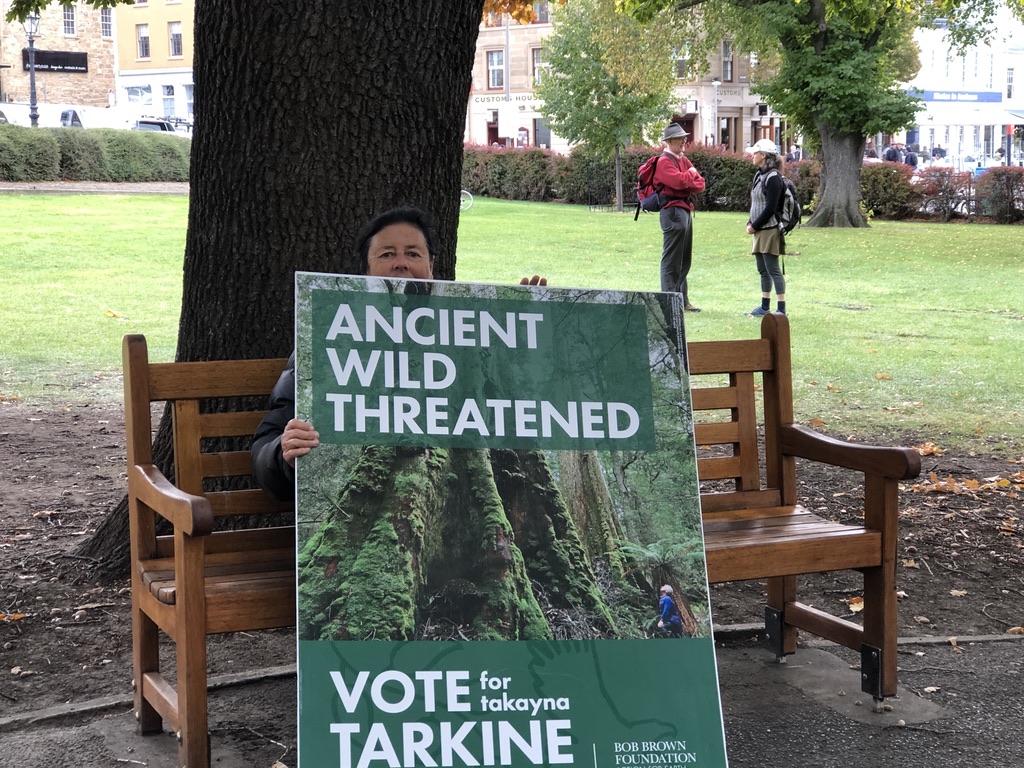
But until then, until those additional people are activated nationally, there is another direct action that is even more powerful and that every one of us can take. Every election, no matter whether local, state or federal, we can vote first for those candidates supporting strong real action on climate and the environment.
The world won’t fall apart, and our economy won’t suffer. It’s a small token we all can make for the future of our precious places, environment, our children, grandchildren and future generations.
Feature photo: Protesting old growth logging, Tarkine, Tasmania. Photo supplied

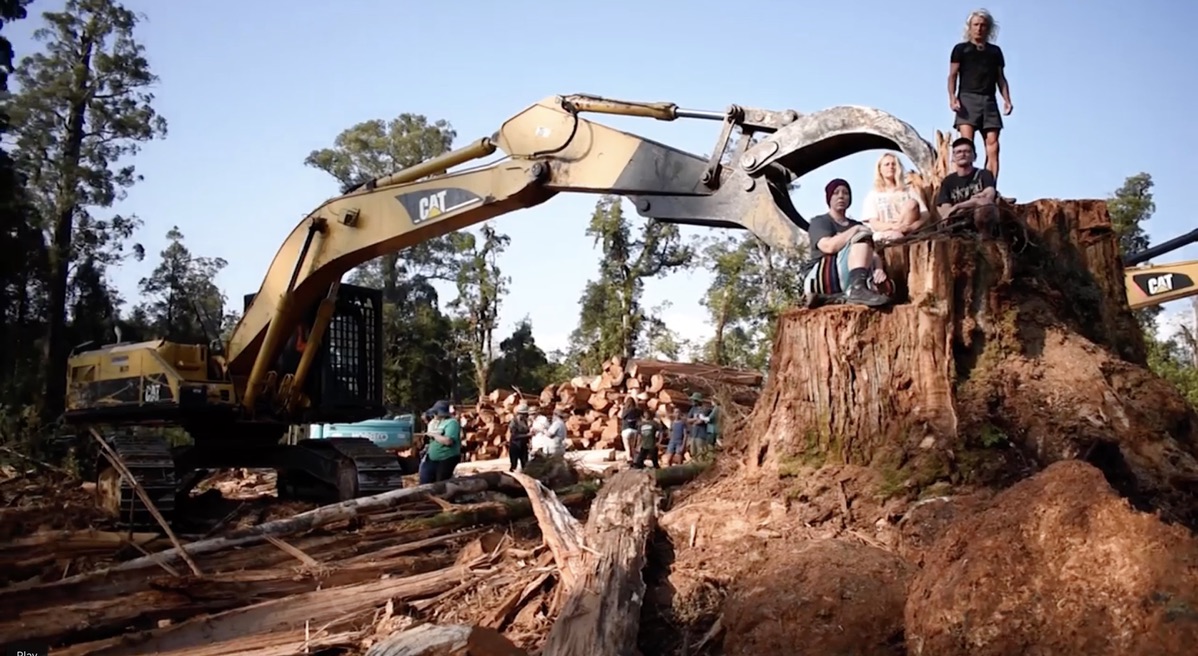





F#@*#”@*ck! I thought we had it bad in NSW with post fire logging. Bonnie this is both outrageous and heart breaking at the same time
The Bob Brown Foundation posted this video yesterday. Over the weekend, clear-felling and burning of forest continue. It is a slap in the face for Tasmanians - or a massive gloat of a statement - that forestry and the Liberals destroying legacy rules supreme. With so much hope being held by conservationists and those who care about the environment that the state election would make a difference and the magnificent ancient forests and our unique Australian wildlife would finally have some protection, this smoke would be triggering grief in those that care. Australia must get behind Tasmania's campaign to save the wilderness just like the country continues to fight to Stop Adani and the mining of the Galilee Basin.
https://fb.watch/5gaJHGrg9d/
So depressing Bonnie. It is so hard to believe that in this day and age and after the recent natural disasters the governments at all levels are still propping up the destructive logging industry. Makes me want to scream.
sad and angry all over again....
at every step, our governments betray us and our children
well written, Bonnie...the pain and passion are right at the surface
I have been to tassie 14 times....and when I am not there, I am planning my next trip
thanks